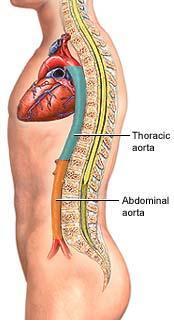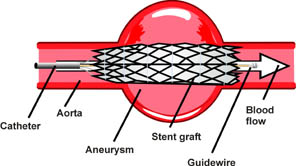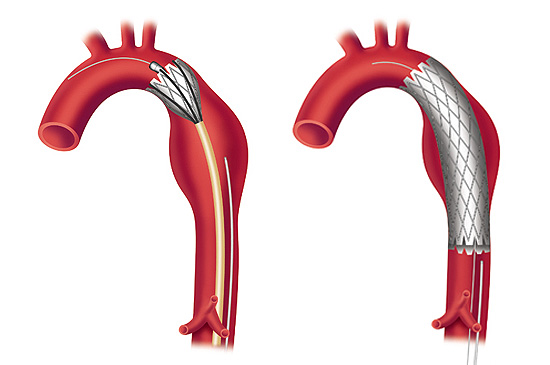If a surgeon deems a heart patient inoperable, there two extremely important questions to ask:
- What makes an aortic aneurysm patient “inoperable”?
- How can we improve on our surgical solutions to save the life of a high risk or “inoperable” aneurysm patient?
First, here is a quick, simple introduction to the technical aspects involved in an aortic aneurysm repair operation. Understanding the challenges will allow you to appreciate the solutions we utilize in high-risk heart surgery cases. These new technologies have made the difference for so many heart patients that were otherwise hopeless and inoperable. We believe strongly in education and offering as many options as possible when it comes to treating an Inoperable Aortic Aneurysm. Let’s start with the basics:

What is the Aorta?
Aorta is the main pipeline in the human body. The heart pumps oxygenated blood in it with every heartbeat. The blood then flows to every organ in the body through side branches of the aorta. This “pipeline” is roughly 1″ in diameter in most people with a normal aorta. The aorta can have a tendency to enlarge and balloon out over time in some patients. This is where we can start analyzing the true nature of the problem when deciding if a situation is truly inoperable. This can also allow us to find the best treatment option when things start to malfunction. Aortic Stenosis or Insufficiency may also have to be considered throughout the diagnosis and treatment considerations.
If the diameter of the aorta grows beyond a critical size, it becomes dangerous and life-threatening. In some cases, the operation to fix this problem might resemble plain and simple plumbing. The portion of our pipeline (the aortic aneurysm) is taken out and replaced by an artificial pipe. This artificial pipe recreates a normal size and function and saves our patients from the risk of a blowout or an aortic dissection. This is what we want to avoid. Early detection can be key in staving off these more major issues down the road.

Your local doctor might deem your situation inoperable if they can’t easily perform the standard fix for this problem.
A Manual for Inoperable Aortic Aneurysms
OK!! Let’s start the list of specific answers to question#1 and question#2. Consider it the troubleshooting chapter of your aneurysm manual.
Problem: “We cannot connect the heart-lung machine or to apply a cross-clamp to stop the heart and perform a repair due to heavy Aorta calcification.”
The calcification makes the aorta “crunchy” and unusable. If you try to stick a cannula in it or a clamp across it, it will crack and release small crumbs of calcium into the general circulation, causing serious problems. These calcium crumbs can float to any blood vessel and effectively block the blood flow to any organ in the body. That is why a situation like this can be so critical. If they go to the brain they’ll cause a stroke. If they go to the kidneys they can cause kidney failure. The list of problems goes on for any organ in the body.
The troubleshooting consists of connecting the heart-lung machine through a branch of the aorta away from the calcified area. If you are told that you are inoperable for this reason, it might be time to search for a second opinion in a reputable high-risk heart surgery center. This more specialized heart surgery center might have more options and be able to deem you a suitable candidate for surgery.
Problem: “You have bad lungs and/or bad kidneys and/or bad liver!”
Other medical conditions can increase surgical risks for patients. It is important to always keep the holistic health of an individual at the forefront of health decisions. Keep in mind, though, that the presence of a significant risk of aneurysm rupture or dissection might still qualify surgery as the best option available. A careful evaluation of the balance between the risk of surgery and the survival benefit of repairing the aneurysm before it bursts can help inform the best decision.
Medical professionals can determine if a technical option is available since every aneurysm case is different. In a specialty center, we can often consider less invasive options that can be better tolerated, even in high-risk patients. A good example involves the ability to deliver a stent inside the aneurysm by using a catheter instead of a surgical operation. See the pictures below to visualize how it is done.

Problem: “The patient, otherwise clear-minded and independent, is too old and/or frail for an open heart operation.”
Well here is a good question to ask if you are told that this is the reason why you are inoperable: “Dear doctor, am I not too old and frail to survive my severe heart condition and avoid a miserable end of my life?” To put it in the words of many feisty octogenarians: “I might be old but I am not ready to die yet!!” While age and frailty are important aspects, they don’t determine surgery qualifications alone. While these are important considerations, they are not the only considerations.
An intelligent conversation has to touch upon each medical or surgical alternative and its related risks and benefits. In other words, what are the risks exactly? If you are told that open heart surgery is very risky, you need to understand the chances of survival for each choice. Let’s suppose you are told that you have a 20% risk of serious complications or death with surgery. Your next question should be: “What are my chances without surgery?” Obtaining as much knowledge as possible will help inform all of your health decisions for the better.
You might have a large aneurysm that is diseased enough to carry a 40% or 50% chance of serious or lethal complications if nothing is done about it. In such a case, avoiding surgery does come with worse consequences. You need to know what your options are. Needless to say, every case is different and you should always discuss your case with an expert medical professional. Expert minimally invasive and high-risk heart surgery centers can offer surgical and catheter-based options. Subsequently, these different options can make a significant difference in the ease of recovery and quality of life. This is why hearing that you have an Inoperable Aneurysm should encourage you to seek a second opinion at the very least.

Problem: “The heart is too weak.”
Ejection Fraction (EF) measures the strength of the heart. A normal EF is 60-65%. The lower the number, the weaker the heart is. The response to this condition can vary significantly among heart specialists. As a result, some surgeons might not be comfortable operating on weak hearts because they feel they might not recover well after surgery. This doesn’t mean that no one will take your case. It just means you need to gather all of the necessary information to truly determine your heart strength before making a final decision. Therefore, always make sure you always cover all of your bases when making important life decisions like surgery.
High-risk heart surgery specialists might offer a more secure outcome by meticulously managing certain heart conditions before, during, and after surgery. They often have more experience with more difficult heart conditions. This can work to your benefit. Adequate preoperative medical intervention can optimize a high-risk heart patient before surgery. Advanced surgical techniques can also assist them during the actual surgery. Finally, they can then recover postoperatively with expert management of congestive heart failure and low ejection fraction.
There are also other reasons why your doctor might consider your condition as inoperable. Please feel free to contact us and discuss your questions and concerns with us.
Schedule Your Consultation With Dr. Ciuffo
Are you a high-risk or inoperable aortic aneurysm patient? If so, all hope is not lost. It is important that you talk with our expert heart surgeon, Dr. Giovanni Ciuffo, for a second opinion. Contact us online or call (712) 294-7055 to schedule an appointment with Dr. Ciuffo.
